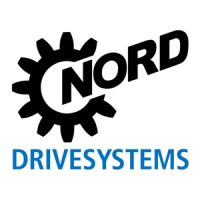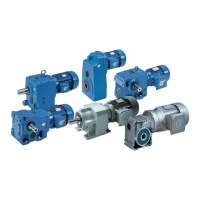-10- B1091-GB-3212 www.nord.com
6. Motors for use in Zone 21
and Zone 22
6.1 General information
The following information applies additionally or especially to motors in categories 2D and 3D!
The motors are suitable for use in Zone 21 (category 2D) or Zone 22 – non-conductive dusts (category 3D)
according to their designation.
Type addition: Zone 21: 2D e.g.: 80 L/4 2D TF
Zone 22: 3D e.g.: 80 L/4 3D TF
The designation is as follows:
0102
II 2 D T 125°C for category 2 (Zone 21)*
Certification number: BVS 04 ATEX E 037
II 3 D T 125°C for category 3 (Zone 22 non-conductive dust)*
* the details of the surface temperature may deviate from 125°C and may be obtained from the name plate
If the motor is connected to a gear, the Ex designation of the gear must also be taken into account!
6.2 Safety information
The increased danger in areas with combustible dust requires that the general safety and commissioning
instructions are strictly complied with. Explosive dust concentrations can cause explosions if ignited by hot or
sparking objects and this can cause severe or even lethal injuries to persons and significant damage to
property.
It is absolutely essential that the persons authorised to use these motors in hazardous areas are trained in
their correct use.
6.3 Commissioning instructions / application area
The motors are suitable for use in Zone 21 (category 2D) or Zone 22 – non-conductive dusts (category 3D)
according to their designation. If the motors are intended for inverter operation, this must be specified when
ordering. The motors must be protected against overheating with suitable monitoring equipment! The dust
levels must not exceed 5 mm! The motors are designed for the voltage and frequency range A as in
EN 60034 Part 1.
Motors for use in Zone 21 and Zone 22, with labelling TF may be thermally monitored via the built-in PTC in
combination with a suitable triggering device as the sole protection. Electrical equipment for use in areas with
combustible dust complies with the standards EN 50281-1-1, EN 60034 and EN 50014. The level of
explosion hazard is determined by the zone separation. The operator/employer is responsible for zone
separation (guideline 1999/92/EC).
If the designation is supplemented by an X, special documentation in the EC type examination certificate
must be complied with. It is forbidden to use standard motors in hazardous areas that are not authorised for
use in hazardous areas. In Zone 21, the cable entries must be authorised for Ex areas (protection class
minimum IP 66) and must be secured against accidental loosening. Unused apertures must be sealed with
authorised plugs (minimum protection class IP 66).
For Zone 22, the cable glands must as a minimum correspond to the protection type specified on the name
plate. Unused openings must be closed with plugs, which as a minimum correspond to the protection class
of the motor.
The motor must not be opened under hazardous atmospheres to connect the electrical cables or for any
other work. The voltage must always be switched off and secured against being switched on again before
opening the motor!

